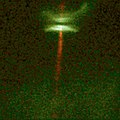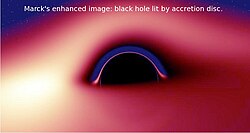Accretion disk
An accretion disk (or disc) is an astronomical term. It describes a disc of material being drawn in by gravity to a centre of mass, such as a star or black hole. As the material comes in, it spins round the central body and radiates energy.
The central body is typically either a young star, a protostar, a white dwarf, a neutron star, or a black hole. As the material moves in, gravitational energy released in that process is transformed into heat and rotational movement.
The energy emitted at the disk surface is in form of electromagnetic radiation. The frequency range of that radiation depends on the central object. Accretion discs of young stars and protostars radiate in the infrared, those around neutron stars and black holes in the X-ray part of the spectrum.
Accretion Disk Media
The hot accretion disc of a black hole, showing the relativistic effects imposed on light when it is emitted in regions subject to extreme gravitation. This image is the result of NASA simulations and shows a view from outside the horizon of a Schwarzschild black hole.
HH-30, a Herbig–Haro object surrounded by an accretion disk
Other websites
- Professor John F. Hawley homepage Archived 2007-09-19 at the Wayback Machine
- Nonradiative Black Hole Accretion Archived 2010-07-23 at the Wayback Machine
- Accretion Discs on Scholarpedia
- Magnetic fields snare black holes' food - New Scientist




